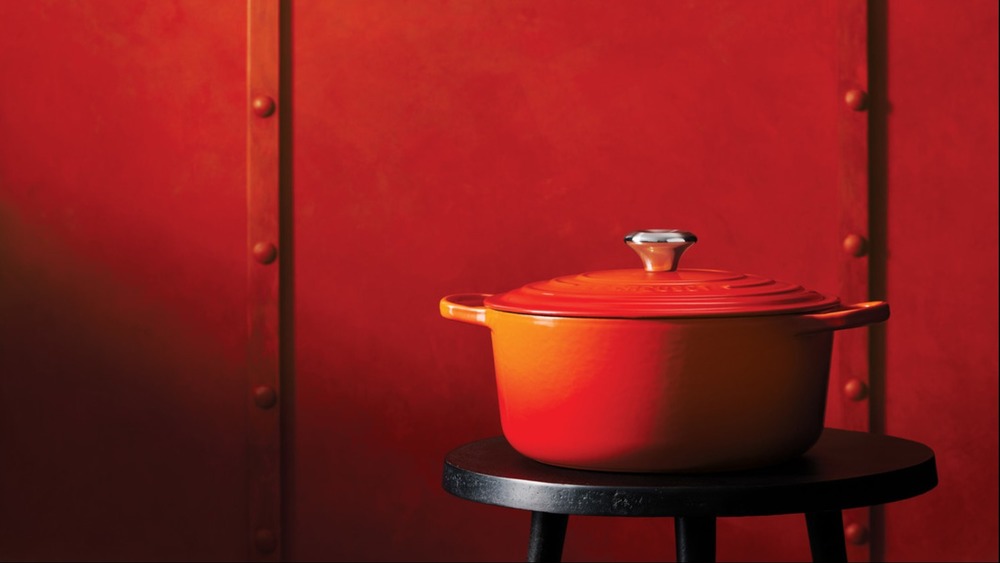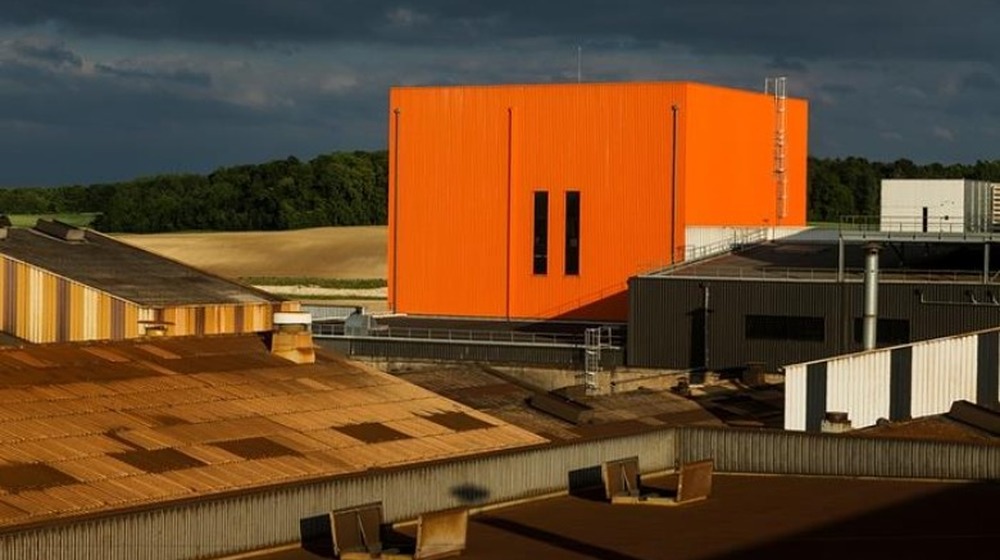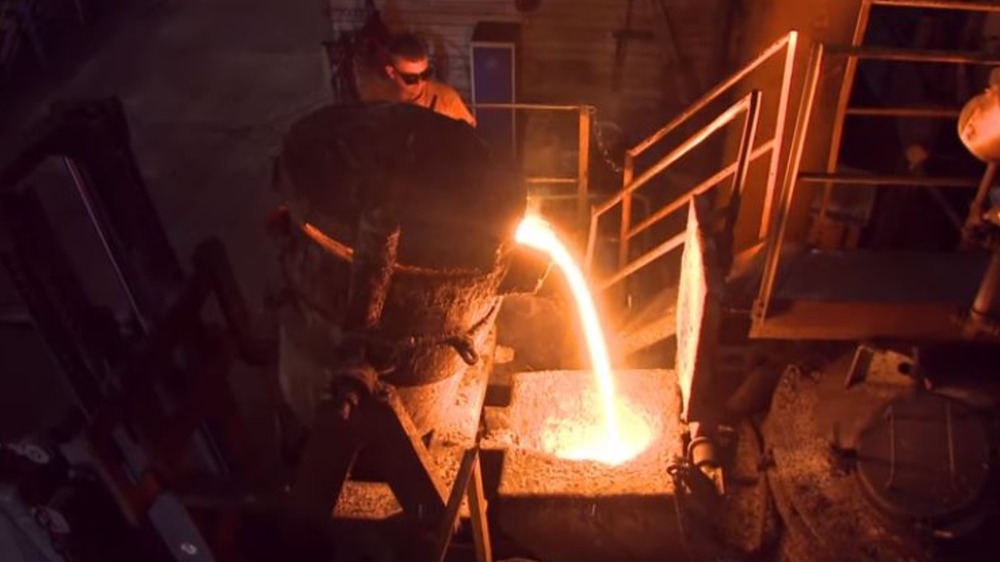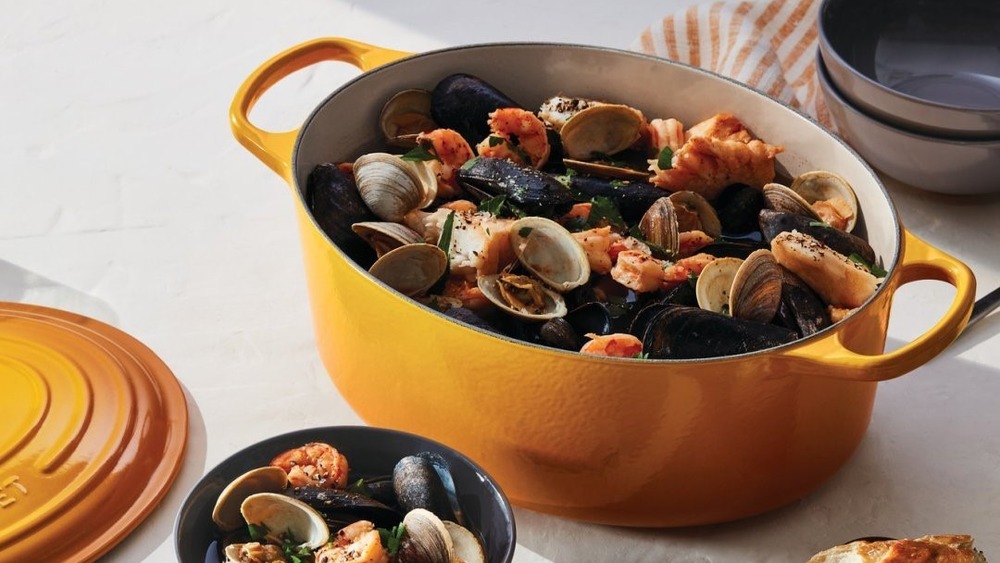The Untold Truth Of Le Creuset
Le Creuset cookware might be as well known for its hefty price tags (up to $675) as it is for the rich, gradient colors of its deep enamel finishes, from the brick red Cerise, to the Mediterranean-inspired Marseille blue, the deep and jewel-like Emerald, and the sunny Soleil. Its beauty, durability, longevity and craftsmanship have also earned Le Creuset icon status among those who love to cook. In the words of Forbes, "Le Creuset Dutch ovens are the gold standard in the category."
Le Creuset was founded in 1925 by Belgian artisans Armand Desaegher, a metal casting expert, and Octave Aubecq, a specialist in the process of enameling, with the goal of bringing something new to a sea of functional-but-uninspiring gray and black cookware that was the standard of the Western hemisphere (via Le Creuset). Le Creuset's philosophy was defined by what the brand calls its Les Trois Vérités or "three essential truths," which are "First, Finest and Favorite."
Let's dive further into the nearly 100-year-old story behind the iconic brand to find out why.
Le Creuset has a long history
Partners Armand Desaegher and Octave Aubecq chose Fresnoy-le-Grand in Aisne, northern France, as the site of their foundry because it was located along the transportation routes for the raw materials they needed: coke, iron, and sand, according to the company. Desaegher and Aubecq refined a glazing process that coated the cast iron cookware in a layer of premium enamel (glass particles that are fused to the iron cookware), making it an excellent and non-porous conductor of heat, not to mention rust-proof and easy to clean.
Although Desaegher and Aubecq were not the first to create enameled cast iron cookware, Le Creuset elevated the glazing process and set the standard for durability and beauty. The first item Le Creuset produced was the cocotte, a smaller version of what would become their famous Dutch oven. The original foundry, its exterior painted in its signature "Flame" hue, is still in use.
Original techniques Le Creuset uses are still relevant
As it was in 1925, Le Creuset's most popular piece is still the Dutch Oven. The piece currently retails between $100 and a jaw-dropping $675 depending on size. Other popular items include the Signature Skillet ($120 to $200), the Braiser ($200 to $360), and the Signature Roaster ($200 to $255) (via Le Creuset).
While some new technologies have been incorporated into the Le Creuset crafting process, much remains unchanged. Individual sand molds are made for each piece, which means each piece is unique (via The Guardian). A mixture of irons and other metals (Le Creuset won't reveal the exact formula) are heated in a cauldron to an incredible 2,700 degrees Fahrenheit (via BRANDMADE.TV). The molds are loaded onto a conveyor where the are filled with the molten metal. The cooled pieces are sandblasted to make them porous enough to accept the enamel. The pieces are then sprayed with primer to prevent rust and spun gracefully on pedestals while sprayers coat them with the colorful enamel for seven seconds before they are oven-fired at nearly 1,500 degrees Fahrenheit.
From start to finish, each piece of Le Creuset is touched by no less than 15 pairs of skilled hands, according to The Guardian. Each piece has a no-flaw policy and melts down imperfect pieces, recycling the iron to be resurrected as a new, flawless pot or pan. They also have a lifetime guarantee, making them heirlooms in many families (via Delish).
Le Creuset is all about a good, vibrant color palette
According to Le Creuset, it was the company's ability to infuse pigment into its glazing process that sparked Le Creuset's early success. Its first enamel color is still its best seller and an icon of the brand.
Creuset is French for "cauldron," or "melting pot" and the ombre "Volcanique" (now called "Flame") was inspired, fittingly, by "the intense, glowing orange hue of molten cast iron in the foundry's cauldron, says Le Creuset. The beauty of the pieces brought about a new way of looking at cookware: It could be not only functional, but it could be enjoyed as a thing of beauty as well. Still today, an evolving collection of vibrant enameling powders in various shades of red, orange, purple, blue, green, and yellow wait in clear plastic tubs (via The Guardian) to be used in the 10,000 pieces of cookware Le Creuset produces each year.
According to Delish, in the last century, Le Creuset has created cookware in about 100 different colors. Many have been around almost as long as the brand, and discontinued colors become collector's items. Color popularity varies from country to country. Delish says that Americans choose mostly primary hues (blue, red and yellow) while Germans veer toward Mediterranean blues, and pastels are favored in Japan. Of course, the French love the signature Flame that made one of their country's most iconic brands so famous. Each year, fans wait for the new Le Creuset colors to drop.
Is Le Creuset worthy of its hefty price tag? According to Cookware Insider, "When you love not only the function of a piece of cookware but also the form, it can make cooking that much easier."



